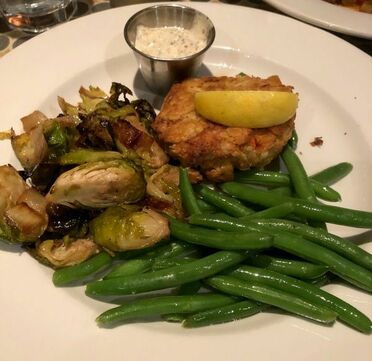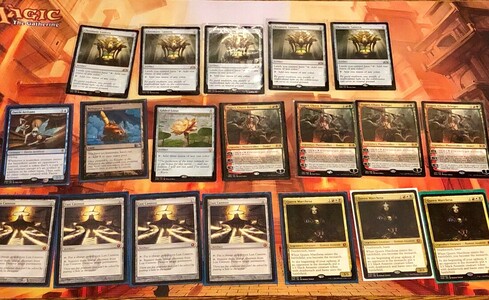|
300 East is a restaurant serving American style cuisine located in the Dilworth neighborhood of Charlotte, NC. The restaurant is in an old Victorian house on East Blvd. Parking is available in the rear lot of the building. They are open seven days a week serving lunch, dinner, and Sunday brunch. They also offer a full bar area and weekday drink specials. According to their website, 300 East has been in business for over 30 years. Ashley and I enjoy dining at 300 East because of the food and experience. The old house creates a perfect ambiance for a cozy date night. We enjoy the wide variety of meat, fish, and vegetarian options on the menu. Their wine list offers enjoyable options at every price. On our last visit, Ashley ordered the Braised Lamb & Mushroom Ragout. It is a hearty dish with goat cheese ravioli. I ordered their popular crab cake entree with sides of brussels sprouts and green beans. I liked the crispy breading along with the generous portion of lump crab inside. We enjoyed our meal with a nice bottle of Rodáno Poggialupi 2016 Super Tuscan. We ordered a dessert, but unfortunately our server forgot to bring it to the table. They do offer a variety of desserts for any sweet tooth.
I would recommend 300 East for any date night or gathering with friends. The location and cozy atmosphere provide a wonderful atmosphere to mingle with others. Magic: The Gathering finance is a hot topic among players interested in earning a profit from buying and selling collectible trading cards. Trying to understand a collectibles market driven by supply and demand is not always easy. Thankfully, there are resources available on the Internet to help with navigating the dynamic market. The popularity of MTG finance has risen thanks to MTG finance-related podcasts and YouTube channels such as MTG Fast Finance, Cartel Aristocrats, and Alpha Investments. One of the points made by many podcast and YouTube personalities is that they understand that speculating comes with inherent risk. There are plenty of stories and videos of people trying to invest in MTG products to turn a profit but come up short. Speculating involves long and short trading. A long trade is when you buy a trading card today to sell it later at a higher price. This type of speculation is more common than shorting in MTG finance. You can conceptually make a short bet on a trading card by selling it today to repurchase it later at a lower price. I recently buylisted a copy of Vivien Reid from Core 2019 to an online vendor for $24.00 on March 13, 2019. The current selling price for a near-mint copy on April 17, 2019, is $18.99. After free shipping and sales taxes, I will come out ahead if I purchased it back. In my opinion, one of the issues with the MTG financial market is the imbalance of long and short trading. Think about how many articles and videos you have seen recommended buying a card instead of selling a card. It is common knowledge when a Standard card will lose value from rotating, but there is much more uncertainty surrounding the timing of a reprint. Often, people will buy cards that work well with a new reprint by betting that demand for a complete deck will rise. An imbalance in market trading can also give rise to market manipulation. Unfortunately, the MTG market is susceptible to manipulation through card buyouts. It does not take a large sum of money to buy all quantities of an older card from online vendors and websites. A buyout will drive up the price of a card to around the last known purchase price. Sometimes, these buyout price changes are temporary, and the card will retrace back to a level close to its pre-buyout price. More often than not, the costs will hold at the new price or somewhere between the two. It is even more accessible for a group of people to work together and target a specific card. I encourage you to be aware of buyouts and how they may impact your decision-making. I am taking on the challenge of understanding the feasibility of an average player making money on collectible trading cards. My goal is to maximize the cash return from speculating. I plan to use any profits to offset my recent, non-speculative purchases. This multi-post series will use a real-life speculating test to understand the barriers of entry, costs associated with speculating, outlets to sell products, and tactics for spotting trends in the market. I will analyze different steps in buying and selling cards through public transactions across multiple websites. While I believe it is possible to make money speculating, I hypothesize that the potential profit margin will not be worth investing time for the average player. Speculation Spreadsheet Available I purchased almost $200 in MTG trading cards from TCGPlayer, Toy Wiz, and eBay to begin my MTG speculation test. My speculation choices did not come from any form of paywall related to a website, Patreon, or insider information. I made choices based on data available to anyone with Internet access. I created an Excel spreadsheet to track my buys and costs associated with acquiring different MTG cards. You can download a copy of my speculation spreadsheet here. I encourage you to use it and follow price changes throughout this test. Understanding Upfront and Selling Costs
Before analyzing my speculation picks, I wanted to understand the upfront costs of acquiring MTG cards. The fees associated with shipping and sales tax significantly impact the profit margins associated with speculating. When purchasing cards over the Internet, I incurred an average of 10% in additional costs between shipping and state sales tax. I spread shipping and sales taxes among the cards in each relevant transaction. Not only do I have to sell these cards later at a higher price, but I also have to cover the 10% fee hurdle. Another cost incurred was my time to research and buy MTG cards. I spent a total of four hours researching and finding the lowest prices available. There is an opportunity cost of the expenditure time purchasing cards instead of working another job or meeting up with friends. Opportunity costs exist in many forms of financial investing. When you decide to save money for retirement instead of spending it today, you are making an opportunity cost decision. This test will mainly focus on the cost of time versus potential profits in sales dollars. How much money do you expect to make for investing X hours on speculating? This question is something you should ask yourself before investing in MTG cards. The third cost associated with speculating is when you sell a card. While different selling platforms have various fees, eBay charges a 10% to 12% fee for sold listings. In addition, PayPal charges a $0.29 base fee plus 2.9% of the transaction. While the Paypal fees can vary based on your account and sales volume, I am using fees that an average person would pay. Shipping an item with a stamp, hard case, and envelop will cost you 55 cents plus material costs. If you need to use a padded envelope with tracking, PayPal offers a discounted rate starting at $2.67. Add these costs together came to an average of 25% of my final sale price per card. This percentage can fluctuate depending on the sale price and the distance a card needs to be shipped. If you sell a card at $50, the fees will be a lower percentage than another card sold for $20 when shipping with tracking and no insurance. I found that selling a card for $7.50 on eBay is the lowest sale I can make to mail with a stamp. Anything lower than $7.50 will cost me higher than 25% of the final sale price in fees. I would be better off pooling multiple copies of a card together as one transaction, buylisting, or selling locally. As for tracking, my lowest sale price for eBay is $25. I should only mail cards sold over $25 with tracking and a padded envelope. One other risk of selling online is shrinkage from becoming lost in the mail or buyer discrepancies. At a minimum, you should expect a loss of 1% of your total transactions. For example, if you average $20 per card across 100 transactions, you will incur $20 in unforeseen losses. Keep in mind that shrinkage affects your bottom line profit margins. My overall transaction costs were estimated at 35% of the total MTG card costs when buying and selling online. These costs decrease when using a vendor buylist, but you should expect a lower cash offer than if you sold cards directly to a buyer. Also, I did not add a cost for the time it takes to research, purchase, or sell cards. It would help if you tried to find ways to lower transaction costs by receiving free shipping from online orders, buying cards locally from other people, and taking advantage of discount promotions whenever possible. In part 2 of this series, I explain the benchmarks surrounding my card choices and the expected hold periods. I will also touch on different ways to lower transaction costs and purchase prices. To view the other posts in this 3-part series on MTG finance speculation, click the links below: Magic: The Gathering Finance Part 2: Analyzing Speculation Targets and Lowering Costs Magic: The Gathering Finance Part 3: Speculation Hits and Misses After 8 Weeks *The information in this article is of my knowledge and opinion and is for informational purposes only. I am not a registered financial professional or trying to act as one.* Last weekend, I took the updated Gruul Aggro deck list from my previous post to a Friday Night Magic event. I made a slight sideboard edit by dropping The Immortal Sun for a Banefire. The FNM event was at The Mighty Meeple with 23 players participating. The recent metagame for this shop is about 50% of the players with aggressive decks, 40% on control decks, and 10% for mid-range decks. There is a nice mix of casual, competitive, and, semi-competitive players at The Might Meeple. I will cover an updated sideboard guide, deck strategies, and FNM recap. Updated Sideboard Guide: Esper Control: -2 Lava Coil, -4 Collision // Colossus, -1 Lightning Strike, -1 Nullhide Ferox, +1 Vivien Reid, +1 Domri, Chaos Bringer, + 3 Cindervines, +2 Legion Warboss, +1 Banefire Reclamation: -2 Lava Coil, -3 Collision // Colossus, -2 Nullhide Ferox, -2 Pelt Collector, +1 Vivien Reid, +1 Domri, Chaos Bringer, + 4 Cindervines, +2 Legion Warboss, +1 Banefire Mono Blue: -3 Nullhide Ferox, -2 Pelt Collector, +1 Shivan Fire, +2 Lava Coil, +2 Legion Warboss Mono Red: -2 Collision // Colossus, -1 Kraul Harpooner, -1 Pelt Collector, +2 Lava Coil, +2 Shivan Fire White Aggro: -3 Collision // Colossus, -2 Kraul Harpooner, -1 Pelt Collector, +2 Lava Coil, +2 Shivan Fire, +2 Fiery Cannonade Sultai Mid-range: -2 Kraul Harpooner, -2 Pelt Collector, +2 Lava Coil, +1 Vivien Reid, +1 Domri, Chaos Bringer Gruul Aggro Mirror: -3 Kraul Harpooner, -1 Lightning Strike, +2 Lava Coil, +1 Vivien Reid, +1 Domri, Chaos Bringer Nullhide Ferox is a beating against many decks in the format for game one. However, you need to expect more board wipes and other answers for games 2 and 3. I like to take one or two Nullhide Ferox out when bringing in the Planeswalkers and Banefire. Pelt Collectors are probably the weakest creature because they do not scale well later in the game. I like trading them out for Legion Warboss against control decks and Mono Blue. Shivan Fire and Lava Coil are all-stars against other creature strategies. Fiery Cannonade is used against go-wide match-ups such as Mono White or Azorious Aggro. You should not bring in Fiery Cannonade against Mono Blue. Cindervines are excellent against control and reclamation strategies. Deck Strategies:
Friday Night Magic Tournament Report: 3rd out of 23 Players Round 1: Win 2-0 against Mono Blue This match was over in two quick games. My opponent was playing Sphinx of Foresight in his deck. While it was strong scrying an extra three cards both games in the opening draw, Sphinx of Foresight is not good. My opponent was punished tapping out every time casting it on turn four or five. Gruul Aggro runs 8+ answers to every creature in Mono Blue. In addition, Mono Blue has no way to block or remove large creatures. My opponent sided in Deep Freeze for game two, but it was not enough to stop all of my threats. Round 2: Win 2-0 against 4-Color Reclamation The first game was over quickly as my opponent flooded out without finding card draw. The second game went much better for them as they landed a Cleansing Nova and Wilderness Reclamation. My opponent then played a Lyra Dawnbringer, but had no protection for it. I luckily drew Vivien Reid to take out Lyra Dawnbringer. Vivien Reid provided enough card advantage to close out the match. Round 3: Loss 1-2 against 4-Color Gates This was a tough match that I was unprepared to face. Gates Ablaze is incredibly strong against Gruul Aggro. In addition, the incremental life gain buys enough time for the Gates deck to find their pieces. I lost game one to double Gates Ablaze and a 10/10 Gatebreaker Ram. Game 2, my opponent stumbled on card draw and mana. I was able to close out the game before they could find a Gates Ablaze. Game 3 was quite close. I unfortunately drew two Skaargan Hellkite and Domri, Chaos Bringer in my first few turns. I got stuck on four lands and could not cast Domri, Chaos Bringer and play a Growth-Chamber Guardian on the same turn. I needed to do this to protect Domri from a Gatebreaker Ram on my opponents board. I believe my opponent should have played more aggressively this game. However, he found an Expansion // Explosion at the right time to draw four cards and close out the match. Round 4: Win 2-1 against Sultai Mid-range I quickly lost game 1 getting stuck on two mana for multiple turns. I let the game play out a while just to see what my opponent had in their deck. I was smart not to show a Nullhide Ferox or any combat tricks while I was losing the game. For game 2, I had an amazing start and my opponent stumbled on four mana. They were unable to hit six lands for a Find // Finality to wipe the board. Game 3, my opponent did not draw answers to a large Nullhide Ferox played on turn three. They tried to stabilize with a Hydroid Krasis, but I had creature removal in hand to get through the final points of damage. I was one turn ahead of them casting a Find // Finality to re-gain board control. There are a handful of movie theaters around Charlotte, NC that hold special movie nights throughout the year. Such events include theatrical release anniversaries, international films, limited release films, and stage-to-screen productions. Often, these showings only happen for one or two days. For example, tickets are available for a special showing of Ben-Hur to celebrate the 60th anniversary of the movie. The easiest way to find tickets for many special events is through Atom Tickets or Fathom Events. One of my favorite features of Regal Stoncrest is their bar area. Their selection of local and national craft beers is better than you would expect. My friends and I usually order a tall draft before seeing a movie. If you are interested in wine, they serve chilled wine by the glass. This is not a standard offering you would expect at a movie theater. Ashley really likes it when wines are kept in a chiller rather than room temperature or stored improperly. Another perk of visiting Regal Stonecrest is their stadium seating. The theaters have stadium seats that recline back and push out a foot rest. They are very comfortable for enjoying any movie. I will typically go out of my way to visit a theater with stadium seating. One point to keep in mind is that Regal Stonecrest has reserved seating. You will need to reserve the best seats ahead of time. My friend and I unfortunately reserved tickets at the last minute for recent a movie and had to sit in the front row. While it was not a great seat in the theater, we were still able to see the whole screen.
Regal Stonecrest is one of the best movie theater experiences in Charlotte, NC. I encourage you take advantage of the amenities the next time you want to see a new or limited release movie. |
Follow me
on Instagram @card_knock_life Categories
All
Archives
July 2024
This website contains affiliate links
|








 RSS Feed
RSS Feed
